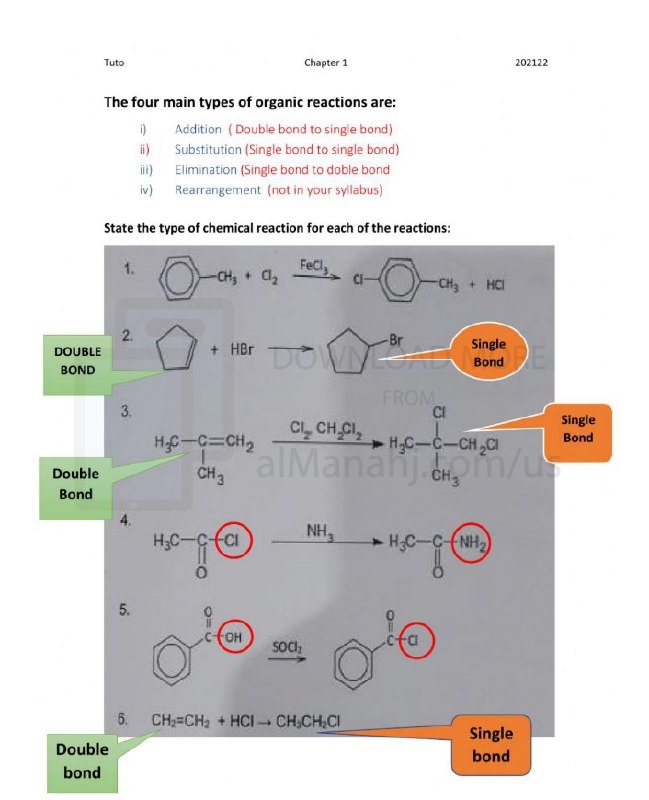| You are here: Almanahj Website ⇒ American curriculum ⇒ 12th Grade ⇒ Chemistry ⇒ Term 1 | ||
|---|---|---|
Worksheet about Types of organic reaction | ||
|---|---|---|
| Subject: Chemistry | ||
| 12th Grade | ||
| Term 1 | ||
| Year: 2023/2024 | ||
| Size: 381.2KB | ||
| Number of clicks: 136 | ||
| Publish date:November 06, 2023 | ||
| Added by: Eman | ||
| Last download date: 2024-09-07 09:13:23 | ||
| Updated by: Eman9966 on 2023-11-06 15:17:41 | By: theodor sapiyan kandong | |
File info: There are several types of organic reactions in chemistry, each characterized by the specific transformations they involve. Here are some common types of organic reactions:1. Substitution Reactions: In substitution reactions, an atom or a group of atoms is replaced by another atom or group of atoms. Examples include nucleophilic substitution reactions, where a nucleophile replaces a leaving group, and electrophilic substitution reactions, where an electrophile replaces a hydrogen atom. 2. Addition Reactions: Addition reactions involve the addition of atoms or groups to a molecule, resulting in the formation of a new product. For example, in an addition reaction, a double or triple bond is broken, and new atoms or groups are added to the reactant molecule. 3. Elimination Reactions: In elimination reactions, a molecule loses atoms or groups, leading to the formation of a double bond or a triple bond. One common example is the E1 and E2 reactions, where a leaving group is eliminated from a molecule, resulting in the formation of a double bond. 4. Oxidation-Reduction Reactions: Also known as redox reactions, these reactions involve the transfer of electrons from one species to another. Oxidation refers to the loss of electrons, while reduction refers to the gain of electrons. Redox reactions are essential in various biological processes and are involved in the energy production of cells. 5. Rearrangement Reactions: Rearrangement reactions involve the rearrangement of atoms or groups within a molecule to form an isomeric product. These reactions typically occur through the migration of a functional group or a hydrogen atom from one location to another within the molecule. 6. Condensation Reactions: Condensation reactions involve the joining of two molecules, often with the elimination of a small molecule such as water or an alcohol. These reactions are commonly observed in the synthesis of polymers and the formation of larger molecules from smaller building blocks. 7. Hydrolysis Reactions: Hydrolysis reactions involve the cleavage of a chemical bond through the addition of a water molecule. This type of reaction is often used to break down large molecules into smaller components. 8. Polymerization Reactions: Polymerization reactions involve the joining of monomers to form a polymer. This process can occur through various mechanisms, such as addition polymerization and condensation polymerization. These are just a few examples of the many types of organic reactions encountered in chemistry. Each type of reaction has its own unique set of conditions, mechanisms, and applications, and understanding them is crucial for studying and manipulating organic compounds. | ||
| Downloading link Worksheet about Types of organic reaction |
|---|
|
1699283042.pdf
The file is being prepared for download
|
| File images |
|---|
 |